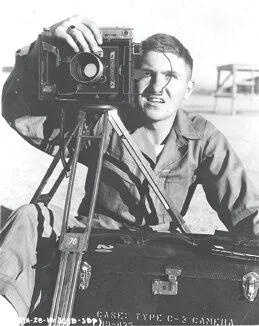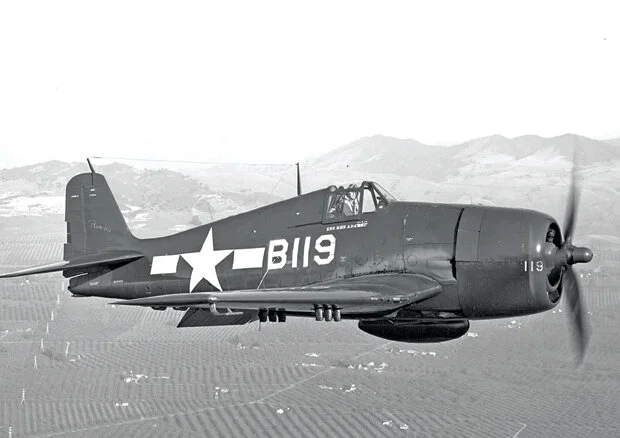Aviation Photography of Bill Larkins During the 1940s
By Pete Shirk
Bill Larkins at Lowry Field AAF Photography School in June of 1943. (Photo taken by a classmate of William T. Larkins)
In In Flight USA’s December 2012 issue, the start of Bill Larkins’ eight-decade photography career was illustrated by the 1938 shot of a Grumman F3F US Navy/Marine biplane fighter parked at the Oakland Airport. Bill was about 16-years old when he took the photo.
During the first part of the next decade, the 1940s, as with many other Americans, Bill was in the military.
Following his graduation from University of San Francisco in 1943 he graduated from AAF Photography School at Lowry Field. He served the next three years in aircraft recognition training followed by three years in the intelligence with the AAF Reserve/USAF, followed by three years with the California Air National Guard.
The 1940s, following WWII, saw the collection of thousands of surplus aircraft at huge depots such as Kingman Army Airfield in Arizona. Some aircraft were cut up and smelted while others were surplused to private owners through the War Assets Administration, which had its own depots at places like Ontario and Buchanan Field in Contra Costa, Calif. Bill was there to document this fascinating period of aviation history. This is the era of intact, flyable, low-time P-51s sold for $1,500! It drives current aviation enthusiasts mad to think of it. Those that weren’t sold were cut for scrap …
Kingman Army Airfield Feb. 8, 1947. (William T. Larkins)
The era is well documented in one of my favorite WTL books, Surplus WWII U.S. Aircraft, William T. Larkins, 2005, BAC Publishers, Inc. (It is available from Amazon and other booksellers.)
During the 1940s many ex-military aircraft found new lives in a variety of commercial enterprises. Curtiss C-46s, Douglas C-47s and C-54s, and Lockheed C-69s were used to birth dozens of new airlines. The War Assets Administration disposal program was immense as the government sought to salvage whatever it could from the thousands and thousands of surplus aircraft. WAA had to dispose of about 200,000 aircraft.
Cal-Aero Academy Field, Ontario, Calif. May 22, 1946. (William T. Larkins)
With Curtis C-46s and ex-military pilots plentiful and cheap many airlines were started in the 1940s. The use of war surplus C-46s expanded greatly and Bill documents that at its height, there were 53 airlines flying 122 of the Curtiss transports based at Oakland Airport’s North Field. Oakland had the room to accommodate them, unlike SFO, and it became the non-sched capital of the West Coast. Most of the companies did not survive, but several recognizable names did such as Air America, Flying Tigers, and World Airways (at least for a while).
The decade of the 1940s saw the re-birth of air racing. Numerous other adaptations were tried including B-17s for forest-fire fighting, Stearmans for crop dusting, and P-61s for aerial photographic mapping, but those primarily came during the 1950s and 1960s – the subject of the next installment.
The 1940s saw a lot of Reserve flying. Here is an F6F-5 over Walnut Creek, Calif. on Feb.17, 1947. (William T. Larkins)
AD-1 and F8F-1 over the Golden Gate Bridge on June 2, 1947. At the time Bill was with the California Air National Guard and duty pilots were only too happy to give a photographer a ride - and earn that flight proficiency pay. (William T. Larkins)





